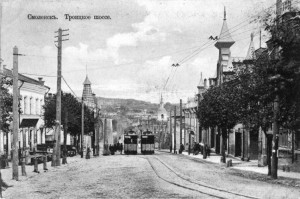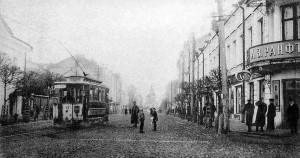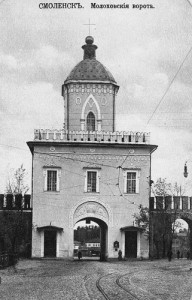October 20, 1901 – Smolensk: AlekseyVT, November 27th, 2011
«Smolensk is a city and the administrative center of Smolensk Region, located on the Dnieper River. Situated 360 kilometers (220 miles) west-southwest of Moscow, this walled city was destroyed several times throughout its long history since it was on the invasion routes of Polish-Lithuanian aggressors, Napoleon Bonaparte and Adolf Hitler. …
Early history
… Smolensk is among the oldest of Russian cities. The first recorded mention of the city was 863 AD, two years after the founding of ancient Russia. According to “Russian Primary Chronicle”, Smolensk (probably located slightly downstream, at the archaeological site of Gnezdovo) was the capital of the Slavic Krivichi tribe in 882 when Oleg of Novgorod took it in passing from Novgorod to Kyiv. …
… In late-19th century through Smolensk were built three railways: Riga-Oryol (1868), Moscow-Brest (1870) and Ryazan-Ural (1899). It became new impulse for the city development. The population of Smolensk was 33890 people in 1881, 45870 – in 1897 and about 59 thousands people – in 1910. By 1900, there were 10 squares, 139 streets, 3261 buildings (including 633 stone), 32 Orthodox Churches, one Catholic Church, one Lutheran Church, two Synagogues, three Monasteries, 33 schools (including one male and one female gymnasiums), 5 printing houses, one chromolithography house, 40 doctors, 27 male and 7 female feldshers, 12 midwifes, 6 pharmacies, 6 drug stores, 8 hospitals with 484 beds, two private hospitals and one provincial hospital in Smolensk. …
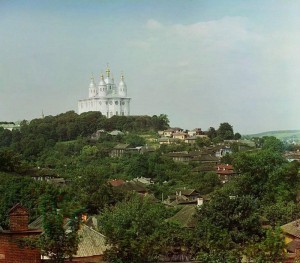 In 1911-1912, to the centenary of the glorious victory, great Russian photographer Sergey Prokudin-Gorsky (1863-1944) made photosession at the places … I offer feel the atmosphere of Smolensk one hundred years ago».
In 1911-1912, to the centenary of the glorious victory, great Russian photographer Sergey Prokudin-Gorsky (1863-1944) made photosession at the places … I offer feel the atmosphere of Smolensk one hundred years ago».
17 цветных фотографий Прокудина-Горского со ссылками на увеличенный размер; краткий комментарий к каждому снимку.
Фото: 1912, Assumption Cathedral in Smolensk. View from the east (color photo of Sergey Prokudin-Gorsky)
Construction of electric tram network
«The first electric lights in the Smolensk Governorate appeared in private companies: on July 13, 1894 two electric light bulbs were lit by Gerhardi roll factory in Smolensk, in January 1898 electricity came on Khludov’s Yartsevsky cotton factory, in May 1898 – on Smolensk Efremenkov’s brewery. …
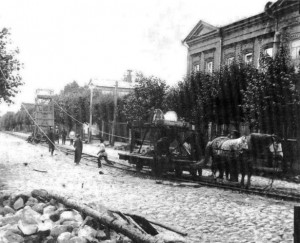 …The tram network was opened on October 20, 1901. There were built two single-track (1 meter wide) tramlines with several passing loops. One line led from the Rail Terminal to the city centre via Dnieper Gate of Smolensk Kremlin; along the New Moscow street, wooden bridge across Dnieper River and Big Annunciation street (now Big Soviet street). After this, line was divided on two branches. One branch led to Pavel Engelhardt street (now Dzerhinsky street); along the Pushkin street (now Lenin street) and St. Elijah street (now October Revolution street) – tramline at two latter streets was laid near northern and western sides of the Blonye Garden. This branch was built through Gubernatorial Break in the Kremlin wall, which was made during 1812-1817 and expanded in 1870. The second branch led to St. Nicholas Gate-Tower, along the St. Nicholas street (now Tukhachevsky street). The routes were: Rail Terminal – St. Nicholas Gate and Rail Terminal – Gubernatorial Break.
…The tram network was opened on October 20, 1901. There were built two single-track (1 meter wide) tramlines with several passing loops. One line led from the Rail Terminal to the city centre via Dnieper Gate of Smolensk Kremlin; along the New Moscow street, wooden bridge across Dnieper River and Big Annunciation street (now Big Soviet street). After this, line was divided on two branches. One branch led to Pavel Engelhardt street (now Dzerhinsky street); along the Pushkin street (now Lenin street) and St. Elijah street (now October Revolution street) – tramline at two latter streets was laid near northern and western sides of the Blonye Garden. This branch was built through Gubernatorial Break in the Kremlin wall, which was made during 1812-1817 and expanded in 1870. The second branch led to St. Nicholas Gate-Tower, along the St. Nicholas street (now Tukhachevsky street). The routes were: Rail Terminal – St. Nicholas Gate and Rail Terminal – Gubernatorial Break.
….Фото: 1900-1901, construction of the tram network
On October 20, 1901 was also opened third route – from Rail Terminal to the Governorate Hospital on Intercession Hill. Unfortunately, opening day was marred by tragic accident. Due to breakage of brake, one of the tramcars lost control and crashed into a Kremlin wall. Some passengers were injured as result of it. …».
7 цветных и черно-белых фотографий.
Далее прослеживаются в виде подборки 58-и ч/б и цветных фотографий и открыток дореволюционные трамвайные маршруты – от первого снимка «1900s, Rail Terminal of Riga-Oryol railway» до 58-го «1900s, Molokhovskaya Gate-Tower»:
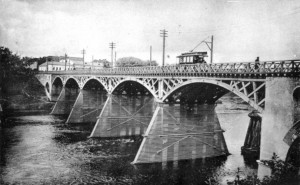
1900s, tramcar on the old wooden bridge across Dnieper River
.
1900s, Trinity Highway (now Big Soviet street)
.
1900s, “Union” tramcar at the Pushkin street (now Lenin street)
1900s, Molokhovskaya Gate-Tower
Персонал:
“The first cash worker and first tram driver in Smolensk” и еще 5 снимков.
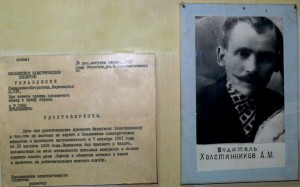
Фото: Identity document of Afanasy Kholstinnikov, who worked by tram driver since October 20, 1901 till August 31, 1915. He finished the work due to mobilization on military service
Современность
“In particular, by 2013 city authorities plan to buy 35 modern low-floor tramcars. Those tramcars (model 71-623, also known as KTM-23) will made at Wagon Works in Ust-Katav town, Chelyabinsk Region. Currently there are 19 such tramcars in Smolensk: 12 tramcars (71-623-01) and 7 tramcars (71-623-00). The first of those tramcars was made in July 2010 and operated in Smolensk since September 3, 2010. The newest tramcars were made in May 2011. …”
21 цветное фото.
Источник:
SkyscraperCity > Infrastructure and Mobility Forums > Subways and Urban Transport> RUSSIA – Trams > Page 11
См.также:
“Смоленск – Исторические фотографии” на СТТС
“Смоленск сквозь века” – проект Смоленского музея-заповедника. Транспорт
Редкие смоленские фотографии начала XX века на биеннале в Санкт-Петербурге
Поделиться ссылкой:


